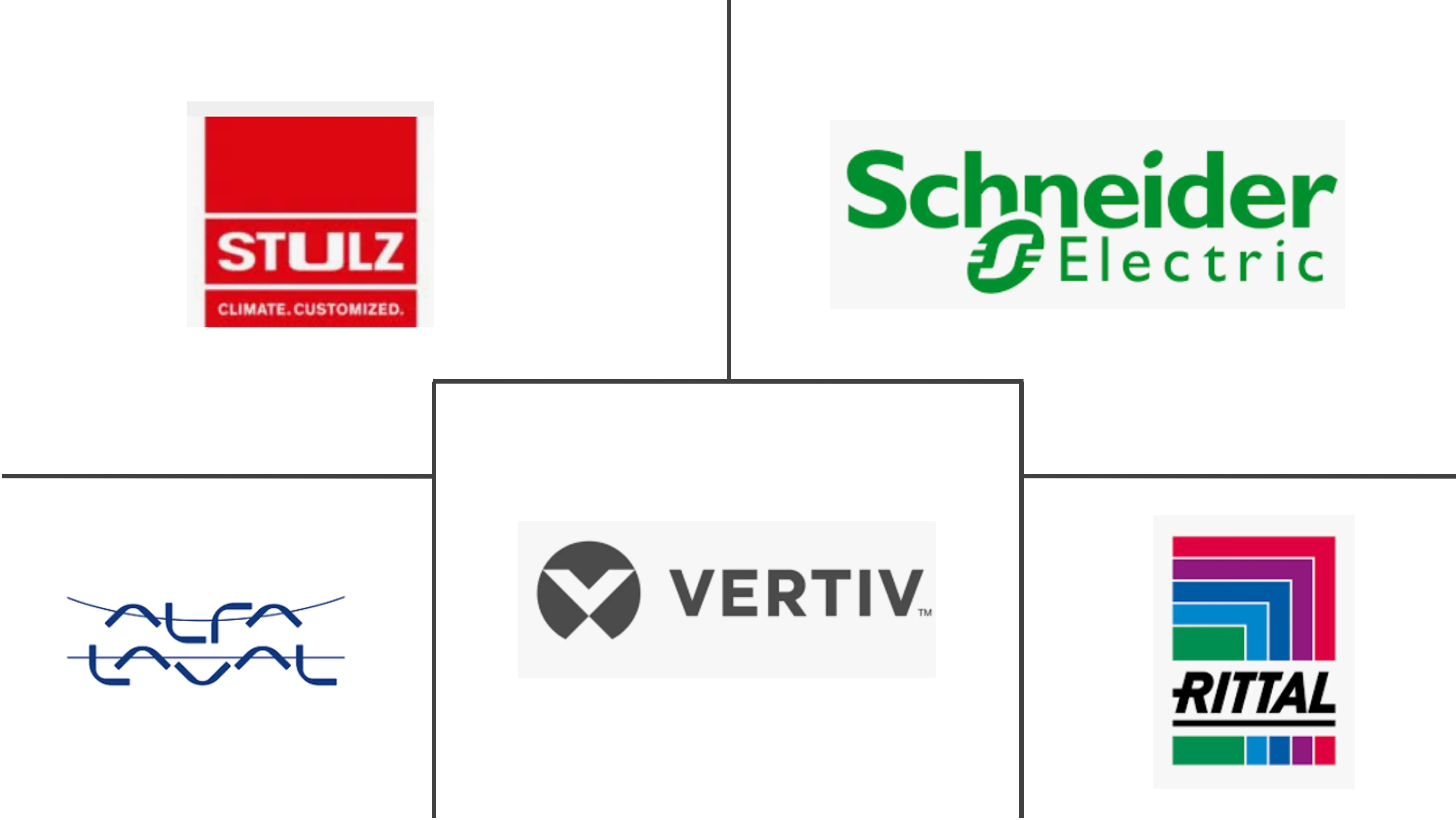Netherlands Data Center Cooling Market Size and Share
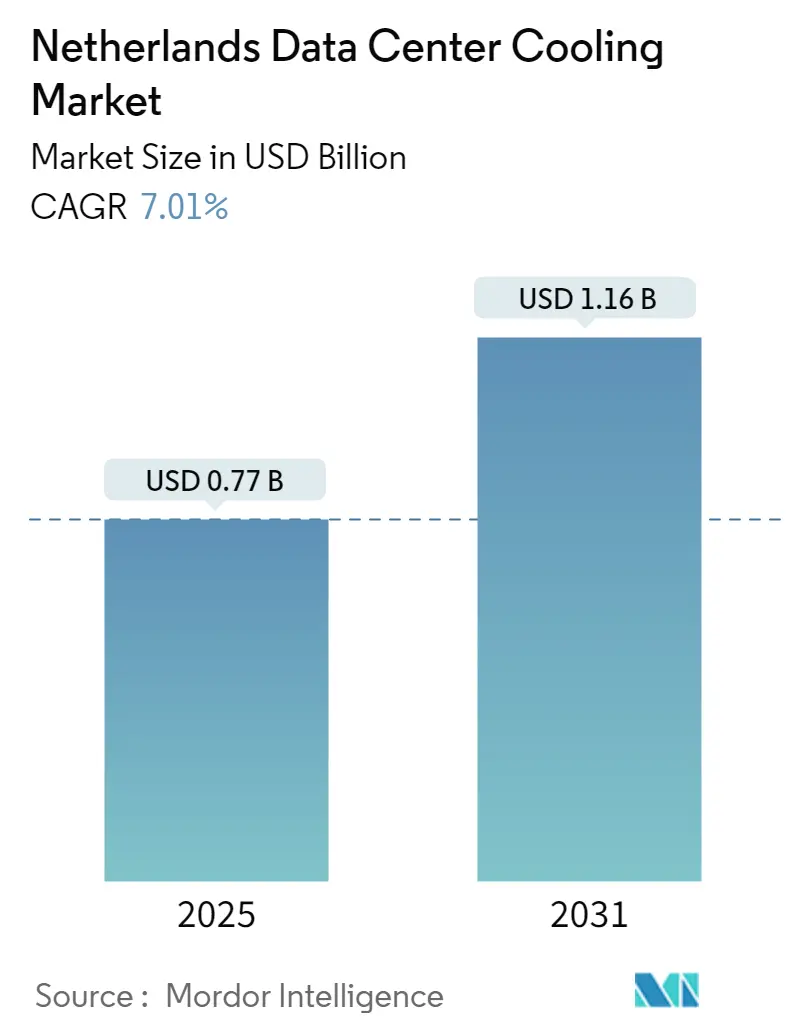
Netherlands Data Center Cooling Market Analysis by Mordor Intelligence
The Netherlands Data Center Cooling Market size is estimated at USD 0.77 billion in 2025, and is expected to reach USD 1.16 billion by 2031, at a CAGR of 7.01% during the forecast period (2025-2031).
- The increasing demand for cloud computing among SMEs, government regulations for local data security, and growing investment by domestic players are some of the major factors driving the demand for data centers in the country.
- Under Construction IT Load Capacity: The upcoming IT load capacity of the Netherlands data center rack market is expected to reach more than 3000 MW by 2030.
- Under Construction Raised Floor Space: The country's construction of raised floor area is expected to increase to more than 6 million sq. ft by 2030.
- Planned Racks: The country's total number of racks to be installed is expected to reach more than 330K units by 2030. Amsterdam will likely house the maximum number of racks by 2030.
- The Netherlands is located in a temperate zone. The country's mean winter temperature is around 3°C, and summer temperatures are about 17°C. Depending upon climatic conditions, the DC cooling is done in the DC facilities.
- Planned Submarine Cables: There are close to 10 submarine cable systems connecting the Netherlands, and many are under construction.
Netherlands Data Center Cooling Market Trends and Insights
IT & Telecommunication Segment holds the Major Share
- The growing demand for affordable data backup, storage, and protection, as well as the need to manage data from the surge in mobile technology usage, cloud storage is witnessing significant growth in the Netherlands.
- The government revised the National Cloud Policy to acknowledge the improved security of public cloud services and the simplified software troubleshooting enabled by mass deployment of updates and patches. Governments are also actively promoting public cloud services and updating regulations to support this growth.
- Hyperscalers like AWS, Azure, and Google Cloud are forging new partnerships with public sector entities and on-premises cloud providers, such as KPN, which offers Azure and AWS services. The Dutch government's actions underscore the cloud's maturity in the nation, highlighting its applicability across diverse government-related scenarios. This indicates an uptick in data center rack utilization.
- Telecom's rollout of 5G is set to enhance data traffic speeds. The country's 3.5GHz (5G) rollout is on track for completion by 2026. By 2030, coverage of the 3.5GHz 5G network is projected to reach 60% of the Dutch population, a significant increase from 33% in 2023. This expansion is likely to boost the popularity of Video on Demand (VOD) services. As a result, the growing demand for data centers in the market is anticipated to drive an increased need for manufacturers of data center cooling infrastructure in the coming years.
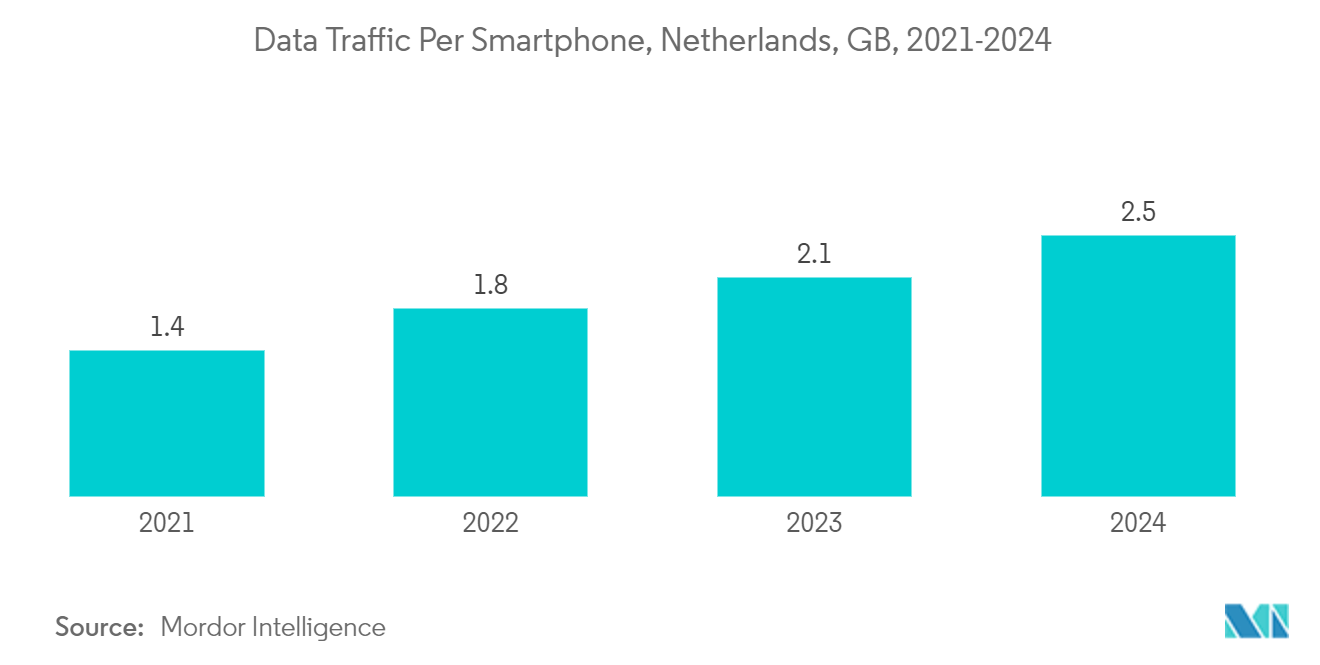
Liquid-based Cooling is the Fastest-growing Segment
- In 2024, the Netherlands data center market is experiencing a significant influx of investments. Notably, Google is channeling EURO 600 million (equivalent to USD 640.62 million) into establishing a new data center in Groningen, a city in the Netherlands. This uptick in investments not only paves the way for the establishment of more data centers but also amplifies the demand for data center cooling equipment in the market.
- Data center operators are increasingly turning to liquid cooling technology to reduce power consumption. For example, in 2024, Switch Datacenters, a prominent developer and operator of sustainable data centers, unveiled its latest facility, AMS4. This 15-18 MW facility emphasizes modular design, sustainability, and robustness, bolstering local capabilities. AMS4's closed-loop cooling system not only minimizes water consumption but also enhances efficiency. Operating entirely on green power, AMS4 utilizes heat capture technology. The heat, generated without fossil fuels, is intended for a new municipal heat grid in Diemen, potentially serving thousands of households. These initiatives address the growing demands for data center cooling.
- Moreover, the government is poised to increase investments in pioneering fields like quantum computing, artificial intelligence, and applications leveraging 5G and 6G technologies. With an ambition to achieve comprehensive 5G coverage, the government scheduled a 5G spectrum auction for 2023. These initiatives are anticipated to bolster the growth and demand for data processing facilities within the telecom sector, subsequently driving up the need for DC cooling infrastructure in the nation.
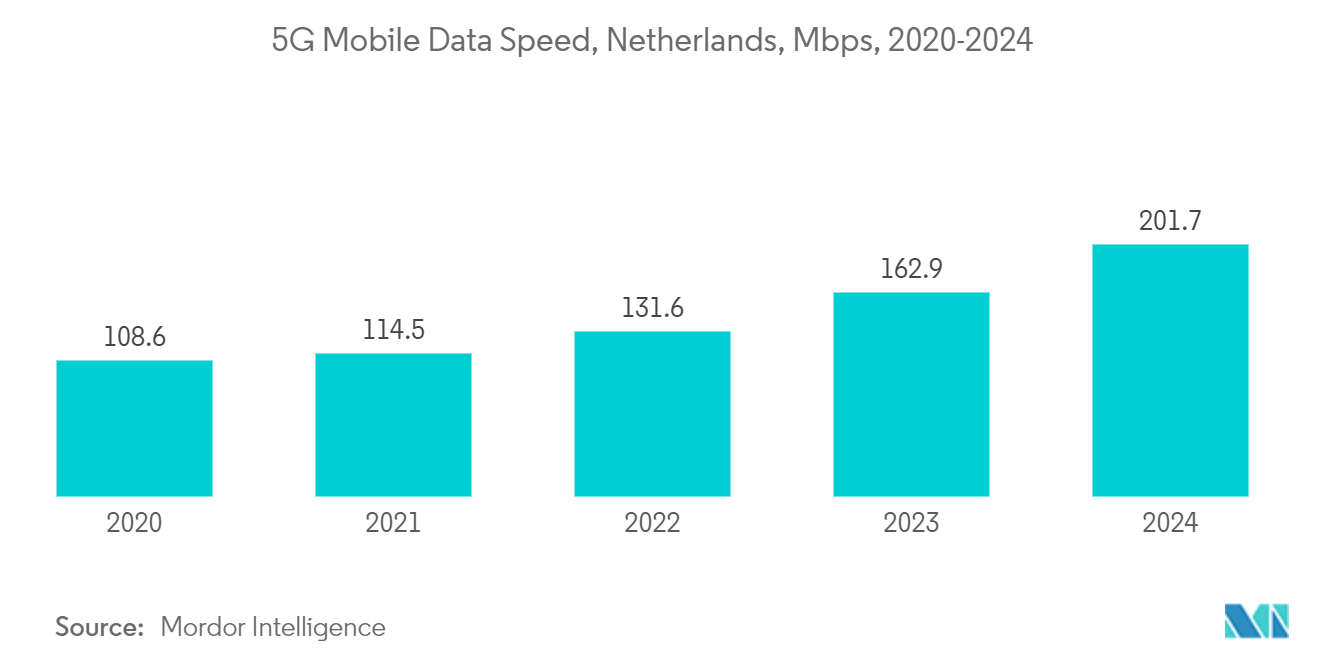
Competitive Landscape
The Netherlands data center cooling market exhibits a moderate level of consolidation among key industry players, having sharpened their competitive edge in recent years. Notable market leaders in this segment include STULZ Gmbh, Rittal GMBH & Co.KG, Schneider Electric SE, Vertiv Group Corp., Alfa Laval AB. and others. These industry giants, boasting significant market shares, are actively engaged in expanding their customer base throughout the region. Their growth strategies primarily hinge on strategic collaborative efforts aimed at enhancing market share and overall profitability. Moreover, companies such as Schneider Electric SE, Vertiv Group Corp., offer both liquid and air based cooling products.
Netherlands Data Center Cooling Industry Leaders
-
Stulz GmbH
-
Rittal GMBH & Co.KG
-
Schneider Electric SE
-
Vertiv Group Corp.
-
Alfa Laval AB
- *Disclaimer: Major Players sorted in no particular order
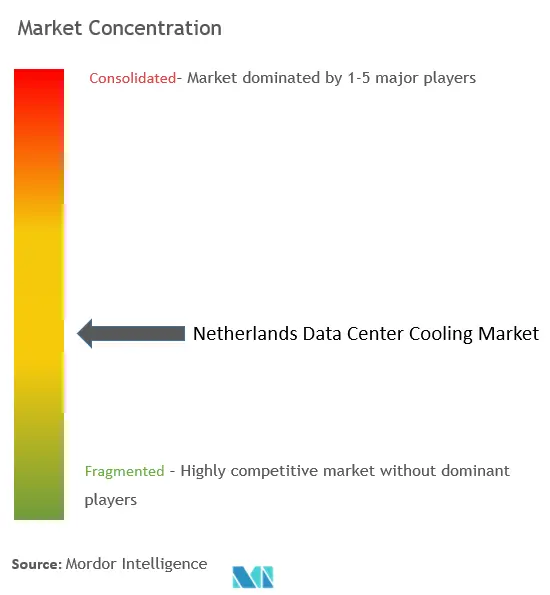
Recent Industry Developments
- September 2024: As artificial intelligence (AI) reshapes industries, AI data centers grapple with escalating energy and cooling demands essential for their high-performance hardware. However, Dutch AI data centers are poised to make substantial strides in sustainability. By leveraging the Infinity Turbine Cluster Mesh Power Generation system, they can cut down on cooling expenses and convert waste heat into electricity, firmly
- July 2024: In a collaborative effort, Penta Infra and heating company Polderwarmte have inked a letter of intent, channeling waste heat from Penta's AMS01 data center in Haarlem, Amsterdam, to warm a nearby business park. This residual heat will be integrated into a district heating system currently under development by Polderwarmte.
Netherlands Data Center Cooling Market Report Scope
Data center cooling is a set of techniques and technologies to maintain optimal operating temperatures in data center environments. Data center cooling is critical as data center facilities house many computer servers and network equipment that generate heat during operation. Efficient cooling systems are used to dissipate this heat and prevent equipment from overheating, ensuring continued reliable operation of the data center. Various methods, such as air conditioning, liquid cooling, and hot/cold aisle containment, are commonly used to control temperature and humidity in data centers.
The Netherlands Data Center cooling market study comprises by Technology (Air-based cooling (Chiller and Economizer, CRAH, Cooling Towers and Others), Liquid-based cooling (Immersion Cooling, Direct-to-chip Cooling, Rear-Door Heat Exchanger)), Type of Data Center (Hyperscaler, Enterprise and Colocation) , by End-User Industry (IT & Telecom, Retail & Consumer Goods, Healthcare, Media & Entertainment, Federal & Institutional agencies, and Other end-users). The market sizes and forecasts are provided in terms of value (USD) for all the above segments.
| Air-based Cooling | Chiller and Economizer |
| CRAH | |
| Cooling Tower (covers direct, indirect & two-stage cooling) | |
| Others | |
| Liquid-based Cooling | Immersion Cooling |
| Direct-to-Chip Cooling | |
| Rear-Door Heat Exchanger |
| Hyperscalers (owned & Leased) |
| Enterprise (On-premise) |
| Colocation |
| IT & Telecom |
| Retail & Consumer Goods |
| Healthcare |
| Media & Entertainment |
| Federal & Institutional agencies |
| Other end-users |
| By Cooling Technology | Air-based Cooling | Chiller and Economizer |
| CRAH | ||
| Cooling Tower (covers direct, indirect & two-stage cooling) | ||
| Others | ||
| Liquid-based Cooling | Immersion Cooling | |
| Direct-to-Chip Cooling | ||
| Rear-Door Heat Exchanger | ||
| By Type | Hyperscalers (owned & Leased) | |
| Enterprise (On-premise) | ||
| Colocation | ||
| By End user Vertical | IT & Telecom | |
| Retail & Consumer Goods | ||
| Healthcare | ||
| Media & Entertainment | ||
| Federal & Institutional agencies | ||
| Other end-users | ||
Key Questions Answered in the Report
How big is the Netherlands Data Center Cooling Market?
The Netherlands Data Center Cooling Market size is expected to reach USD 0.77 billion in 2025 and grow at a CAGR of 7.01% to reach USD 1.16 billion by 2031.
What is the current Netherlands Data Center Cooling Market size?
In 2025, the Netherlands Data Center Cooling Market size is expected to reach USD 0.77 billion.
Who are the key players in Netherlands Data Center Cooling Market?
Stulz GmbH, Rittal GMBH & Co.KG, Schneider Electric SE, Vertiv Group Corp. and Alfa Laval AB are the major companies operating in the Netherlands Data Center Cooling Market.
What years does this Netherlands Data Center Cooling Market cover, and what was the market size in 2024?
In 2024, the Netherlands Data Center Cooling Market size was estimated at USD 0.72 billion. The report covers the Netherlands Data Center Cooling Market historical market size for years: 2019, 2020, 2021, 2022, 2023 and 2024. The report also forecasts the Netherlands Data Center Cooling Market size for years: 2025, 2026, 2027, 2028, 2029, 2030 and 2031.
Page last updated on:
Netherlands Data Center Cooling Market Report
Statistics for the 2025 Netherlands Data Center Cooling market share, size and revenue growth rate, created by Mordor Intelligence™ Industry Reports. Netherlands Data Center Cooling analysis includes a market forecast outlook for 2025 to 2031 and historical overview. Get a sample of this industry analysis as a free report PDF download.
